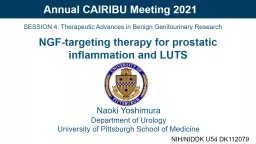

Naoki Yoshimura Department of Urology University of Pittsburgh School of Medicine Annual CAIRIBU Meeting 2021 SESSION 4 Therapeutic Advances in Benign Genitourinary Research NIHNIDDK U54 DK112079 ID: 909058
Download Presentation The PPT/PDF document "NGF-targeting therapy for prostatic infl..." is the property of its rightful owner. Permission is granted to download and print the materials on this web site for personal, non-commercial use only, and to display it on your personal computer provided you do not modify the materials and that you retain all copyright notices contained in the materials. By downloading content from our website, you accept the terms of this agreement.
Slide1
NGF-targeting therapy for prostatic inflammation and LUTS
Naoki YoshimuraDepartment of UrologyUniversity of Pittsburgh School of Medicine
Annual CAIRIBU Meeting 2021
SESSION 4: Therapeutic Advances in Benign Genitourinary Research
NIH/NIDDK U54 DK112079
Slide2BPH
Urethra is compressed
due to prostate
hyperplasia
(transition region)
Transition region
Marginal region
Central region
Normal
Normal voiding is
possible
(urethra is not compressed)
Compression
Inflammation
Voiding symptoms
Storage symptoms
Hypertrophy
IschemiaAfferent activation(Positive ice-water test)
Bladder
Prostate/Urethra
BPH and Lower urinary tract symptoms (LUTS)
Significant correlation between LUTS and prostatic inflammation in BPH patients
Slide3Afferent sensitization following prostatic inflammation
Bladder
Prostate
DRG
Spinal cord
Prostatic inflammation
Bladder overactivity
In dichotomized (18-19%) and bladder afferents,
TRPV1, TRPA1
ATP receptor P2X
2
+
Hyperexcitability of bladder afferent neurons & Kv1.4
Bladder urothelium- Nerve Growth Factor (
NGF)
Afferent sensitization
Rat model:
intraprostatic formalin injection
Funahashi et al., J Physiol 597:2063-2078, 2019
Mouse model:
prostate-specific E-cadherin downregulation
Pascal et al., Endocrinology 162, 1–15, 2021
Slide4Neurotrophic factors & their receptors
Nerve growth factor (NGF) -TrkA
Brain-derived neurotrophic factor (BDNF)- TrKBNeurotrophin 3 (NT-3)- TrkC
Intravesical NGF-targeting therapy
Liposome-conjugated NGF antisense
Trk receptor-targeting therapy
Trk receptor antagonist (GNF 5837)
Slide5Liposome-based Therapy
Intravesical liposomal application
Clinical
Empty liposomes
BPS/IC
Botulinum toxin
BPS/IC
OAB
Pentosan polysulfateBPS/ICTacrolimus (FK506)Hemorrhagic cystitisPre-clinicalNGF antisense
Spherical vesicle consisting of lipid bilayers
Slide6Nerve growth factor (NGF) and afferent sensitization
-Our previous findings-
Anti-NGF antibody treatment in the spinal cord reduces bladder overactivity in spinal cord injured (SCI) rats
(J Urol, 2002, 2004)
Spinal cord NGF administration induces DO and C-fiber bladder afferent hyperexcitability in rats
(J Neurosci, 2006)
Anti-NGF antibody treatment reduces DO & bladder afferent hyperexcitability in SCI mice
(N&U; Exp Physiol, 2018)Prostatic-to-bladder cross sensitization after prostatic inflammation induces bladder NGF upregulation (J Physiol, 2019) Liposome-based intravesical NGF antisense therapy reduces bladder hypersensitivity in colitis rats and enhanced vascular responses (autonomic dysreflexia) in SCI rats (J Urol, 2016; Exp Neurol, 2017 )
Slide7NGF-targeting therapy- Rat model of prostatic inflammation (PI)
Liposome-conjugated NGF antisense therapy in the bladder reduced bladder overactivity and afferent activity (
TRPV1/TRPA1 in L6-S1 DRG) in PI rats
*P<0.05
N=9 each
Cystometry
Bladder NGF
L6/S1 DRGICI: Intercontaction intervalOn day 14 after PI induction, liposome conjugated NGF antisense (PI-OND) was instilled directly the bladder
On day 28, therapeutic effects were evaluated Igarashi et al., The Prostate. 81: 1303–1309, 2021
Slide8Neurotrophic factors & their receptors
Nerve growth factor (NGF) -TrkA
Brain-derived neurotrophic factor (BDNF)- TrKBNeurotrophin 3 (NT-3)- TrkC
Intravesical NGF-targeting therapy
Liposome-conjugated NGF antisense
Trk receptor-targeting therapy
Trk receptor antagonist (GNF 5837)
Slide9Trk receptor antagonist (GNF 5837) - Rat & Mouse models of PI
Trk receptor blockade (systemic) reduced bladder overactivity and prostatic inflammation (IL-1
)
in PI models.
GNF 5837 (40mg/kg) was orally administered daily for 10 days
2. Mouse PI model
(prostate-specific E-cadherin downregulation; Cdh-/-)
1. Rat PI model
(intraprostatic formalin injection)NVC= non-voiding contractionPlaceboTreatment
PlaceboTreatmentPlacebo treatment P<0.001 P<0.05
P<0.01
Slide10NGF-targeting therapy- Summary/Conclusion
NGF upregulation in the bladder is an important mechanism inducing prostate-to-bladder cross sensitization due to PI, leading to bladder overactivity
Liposome-based intravesical NGF antisense therapy
reduces bladder overactivity and afferent sensitization indued by PI
Trk receptor inhibition therapy
reduces PI-induced bladder overactivity and inflammatory responses in the prostate
NGF-targeting therapy could be effective for the treatment of storage LUTS in BPH patients with prostatic inflammation
Slide11Acknowledgements
Zhou WangShinsuke Mizoguchi
Jianshu Ni
Pradeep TyagiEduardo AlexandreMeri Okorie
Donald B. DeFranco
Pitt: Urology
Pitt: Pharmacology & Chemical Biology
Supported by NIH/NIDDK U54 DK112079
Lori A. Birder
Amanda Wolf-Johnston
Youko Ikeda
Anthony J. Kanai
Pitt: Medicine
Slide12Thank You
Pittsburgh-downtown